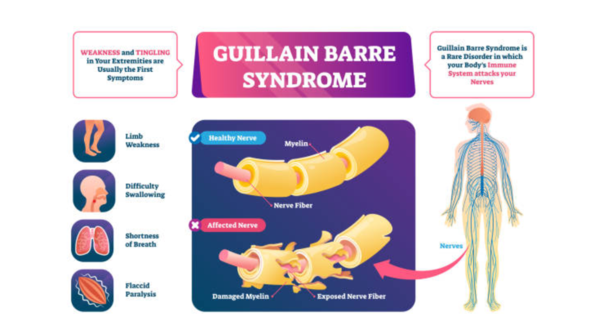AA
Text Size
- Small
- Medium
- Large

1/16
111 cases of GBS identified in Pune in 3 weeks
Guillain-Barré Syndrome is an uncommon, rare neurological condition in which the immune system mistakenly attacks the body’s nervous system causing muscle weakness, numbness, and in extreme cases, paralysis. Campylobacter jejuni (C. jejuni), a bacterium known to cause foodborne illness, is one of the most common infectious agents linked with GBS and also the reason behind the recent outbreak of GBS in Pune, where 111 cases of the diseases have been identified in 3 weeks.

2/16
Several other infections also trigger GBS
Many other infections, bacterial and viral, have also been implicated in triggering the GBS syndrome. While Campylobacter jejuni is the most commonly associated infection with Guillain-Barré Syndrome, the range of other infections that trigger the condition also includes viral, bacterial, and parasitic infections. Understanding the many different triggers and mechanisms found in GBS is essential for proper diagnosis and treatment

3/16
Campylobacter jejuni
C. jejuni is the most common cause of bacterial gastroenteritis globally and is the most frequently implicated bacterium in GBS. Molecular structures that certain strains of C. jejuni share with components of human peripheral nerve gangliosides may be involved in molecular mimicry leading to autoimmune response and GBS. The history of preceding C. jejuni infection may present with diarrhea, abdominal discomfort, and fever.

4/16
Epstein-Barr Virus (EBV)
EBV, a herpesvirus that causes infectious mononucleosis, is another infectious pathogen linked to GBS. EBV infection can lead to an abnormal immune response that targets myelin or axonal structures in the peripheral nervous system. This association is thought to arise from the virus’s ability to alter immune regulation and induce inflammation.

5/16
Cytomegalovirus (CMV)
CMV, yet another causative agent of GBS is also reported and isolated from the herpesvirus group. CMV infection usually causes flu-like illness or may be inconspicuous in immunocompetent hosts. In GBS, it is thought that the immune response induced against the antigens of CMV cross-reacts with those of nerve gangliosides causing damage to nerve tissue. GBS associated with CMV infection tends to have sensory deficits and severe weakness of muscles.

6/16
Zika virus
The emergence of Zika virus outbreaks has highlighted its role as a potential trigger for GBS. Zika virus, transmitted primarily through mosquito bites, is known for causing fever, rash, and joint pain. In some cases, Zika virus infection has been followed by the onset of GBS. The exact mechanism remains unclear but is thought to involve immune system dysregulation and molecular mimicry.

7/16
Influenza virus
The influenza virus, which causes seasonal flu, has also been linked to GBS. Although extremely rare, cases of GBS have been reported after influenza infection. It is thought that the immune response initiated by the virus may, in some way, mistakenly attack peripheral nerves. This association has led to questions about the safety of flu vaccines, although the risk of GBS from influenza vaccination is much lower than the risk of GBS following influenza infection.

8/16
Human Immunodeficiency Virus (HIV)
Neurological complications of HIV infection include GBS. At the early stage of HIV infection, the immune system may generate antibodies that react with nerve tissues and cause GBS. Additionally, HIV infection of peripheral nerves is directly responsible for inflammation and destruction. GBS associated with HIV has features of severe weakness and rapid progression.

9/16
Mycoplasma pneumoniae
Mycoplasma pneumoniae, a common cause of respiratory infections, has also been linked to GBS. The mechanism is thought to involve immune cross-reactivity between bacterial antigens and nerve components. Patients with GBS triggered by Mycoplasma pneumoniae may present with respiratory symptoms, such as cough and sore throat, preceding neurological symptoms.

10/16
COVID
Since the COVID-19 pandemic began, there have been numerous reports of GBS following SARS-CoV-2 infection. The exact relationship is still under investigation, but it is believed that the hyperinflammatory response triggered by the virus may contribute to the development of GBS. In some cases, GBS has been reported after COVID-19 vaccination, but this remains exceedingly rare compared to the overall benefits of vaccination.
A study published in 2023 highlighted the association of GBS and COVID. “The GBS symptoms began on average 19 days after the onset of COVID-19 infection. Regarding GBS, the main manifestations found included generalized weakness, reflex reduction, facial paresis/paralysis and hypoesthesia,” it said after examining 156 studies.

11/16
Hepatitis viruses
Hepatitis A, B, and E viruses have all been implicated in GBS. The mechanisms vary depending on the virus but generally involve immune-mediated damage to the peripheral nervous system. For example, hepatitis E virus is particularly notable for its association with GBS in endemic regions. Patients may present with jaundice, fatigue, and elevated liver enzymes preceding neurological symptoms.

12/16
Varicella-Zoster Virus (VZV)
VZV, the virus responsible for chickenpox and shingles, has also been associated with GBS in rare cases. Reactivation of the virus in older adults or immunocompromised individuals causes inflammation and immune-mediated damage to peripheral nerves.

13/16
Enteroviruses
Enteroviruses, including poliovirus, coxsackievirus, and enterovirus D68, have been associated with GBS. These viruses can directly infect motor neurons or trigger an immune response that damages peripheral nerves. Enteroviruses are more commonly linked to paralysis than GBS, but overlapping features exist.

14/16
Other bacterial infections
Several other bacterial infections have been associated with GBS, including:
Salmonella species: Similar to C. jejuni, Salmonella can trigger an immune response that may cross-react with peripheral nerves.
Haemophilus influenzae: Respiratory infections caused by Haemophilus influenzae have occasionally preceded GBS.
Borrelia burgdorferi: The bacterium responsible for Lyme disease can lead to neurological complications, including GBS, in some cases.

15/16
Parasites
Parasitic infections, although less commonly associated with GBS, can also serve as triggers. For example, Plasmodium falciparum, the parasite responsible for severe malaria, has been implicated in rare cases of GBS. The immune response generated during parasitic infections can sometimes target peripheral nerves, leading to autoimmune complications.

16/16
How do these infections cause GBS?
While the specific mechanisms may vary depending on the infectious agent, the underlying processes often share common themes:
Molecular mimicry: Many infectious agents express antigens that closely resemble components of human peripheral nerves, such as gangliosides. The immune system, in targeting these microbial antigens, inadvertently damages nerve tissues.
Immune dysregulation: Certain infections can disrupt normal immune regulation, leading to an exaggerated inflammatory response that targets peripheral nerves.
Direct neurotropism: Some pathogens can directly infect nerve tissues, causing inflammation and damage.
Hyperinflammatory states: Infections that induce a systemic inflammatory response, such as sepsis or cytokine storms, can contribute to immune-mediated nerve damage.
FOLLOW US ON SOCIAL MEDIA
Visual Stories
Bigg Boss
Photostories
I’m Manas Ranjan Sahoo: Founder of “Webtirety Software”. I’m a Full-time Software Professional and an aspiring entrepreneur, dedicated to growing this platform as large as possible. I love to Write Blogs on Software, Mobile applications, Web Technology, eCommerce, SEO, and about My experience with Life.



